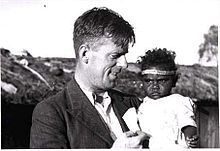Norman Tindale
Norman Barnett Tindale AO , (born October 12, 1900 in Perth , Western Australia , Australia , † November 19, 1993 in Palo Alto , California , USA ) was an Australian anthropologist , entomologist and ethnologist . He was the curator of Aboriginal anthropology at the South Australian Museum . His most famous publication is the Australian Aboriginal tribal boundary map.
Early years
Norman Tindale grew up in his family as the oldest of four children. When he was seven years old, his family moved from Perth to Tokyo , where his father was an accountant in the Salvation Army . In Japan he went to a school with diplomatic children who were also taught in French and German. Since he played with children in his neighborhood after school, he learned the Japanese language colloquially. During this time his interest in nature observation and anthropology developed, for example he collected and classified butterflies at the age of ten.
In August 1915 his family returned to Perth. She moved to Adelaide in February 1917 , where he took up a position at the Adelaide Public Library in May 1917 . When he assisted his father with the use of a flash, an acetylene gas explosion ensued and he became blind in one eye.
scientist
In January 1919, Norman Tindale was hired as an entomologist at the South Australian Museum by Arthur Mills Lea .
In 1921 he was on a field survey on Groote Eylandt in the Gulf of Carpentaria in Queensland . There he came into contact with the Aborigines of the Anindilyakwa, who showed him the exact course of their tribal borders. The existence of tribal borders contradicted the current British legal conception, which had declared the entire Australian continent " Terra Nullius ", a land that no one owned and that European colonists could appropriate. Norman Tindale published the map of the tribal borders of the indigenous population of Australia in 1940, which he revised in 1974.
Tindale was a founding member of the Anthropological Society of South Australia in 1926 . In the 1920s he perfected his geological knowledge by attending training courses from the polar explorer Douglas Mawson . This enabled him to classify an archaeological site in a stratigraphic way . He was the first archaeologist to do this in Australia.
A scientific degree, the Bachelor of Science , was only awarded to him in March 1933 by the University of Adelaide . Before that, he had already written 31 scientific articles. On behalf of the University of Adelaide, he undertook expeditions from 1938 to 1939 and 1952 to 1954, which took him to Aboriginal mission stations throughout Australia. Tindale also created film documentaries during these times. He photographed thousands of Aboriginal people in the 1960s.
In 1967 he was made an honorary doctorate from the University of Colorado Boulder and received a teaching position there .
Participation in World War II
After the attack on Pearl Harbor on December 7, 1941 by the Imperial Japanese Navy Air Forces , other states declared war on Japan, including Australia. Because of his limited vision, Tindale considered himself unfit for war. This changed after the bombing and he was inducted into the Royal Australian Air Force with the rank of Wing Commander in 1942 because of his knowledge of the Japanese language . Tindale was involved in deciphering the secret code of the Japanese naval forces, the production codes of crashed Japanese military aircraft, and in preventing incendiary bombing of Australia.
Honors
Tindale's scientific achievements were honored with the Verco Medal of the Royal Society of South Australia in 1956 , the Australian Natural History Society Medallion in 1968 and the John Lewis Medal of the Royal Geographical Society of Australasia in 1980 .
After his death, Tindale was named Officer of the Order of Australia . In 1993 the South Australian Museum named a public gallery after him.
Web links
- Atlas: boundary lines of the tribes of the Aborigines
- Tindale scientific estate at the South Australian Museum
Individual evidence
- ↑ adb.anu.edu.au : Hans Mincham: Cooper, Harold More (1886–1970) , in English, accessed December 31, 2012.
- ↑ a b c d e f g anu.edu.au : Philip G. Jones: Norman B. Tindale, October 12, 1900 - November 19, 1993 , in English, accessed December 27, 2012
- ↑ adb.adb.anu.edu.au : EG Matthews: Lea, Arthur Mills (1868–1932)
- ↑ samuseum.sa.gov.au ( Memento of the original from March 20, 2012 in the Internet Archive ) Info: The archive link was inserted automatically and has not yet been checked. Please check the original and archive link according to the instructions and then remove this notice. : Tindale, Dr Norman Barnett (AA 338) , in English, accessed December 27, 2012
- ↑ slq.qld.gov.au : Tindale Genealogical Collection , in English, accessed on 28 December 2012
- ↑ itsanhonour.gov.au : Tindale, Norman Barnett (Officer of the Order of Australia), in English, accessed December 27, 2012
| personal data | |
|---|---|
| SURNAME | Tindale, Norman |
| ALTERNATIVE NAMES | Tndale, Norman Barnett (full name) |
| BRIEF DESCRIPTION | Australian anthropologist, entomologist and ethnologist |
| DATE OF BIRTH | October 12, 1900 |
| PLACE OF BIRTH | Perth , Western Australia, Australia |
| DATE OF DEATH | November 19, 1993 |
| Place of death | Palo Alto , California, USA |
